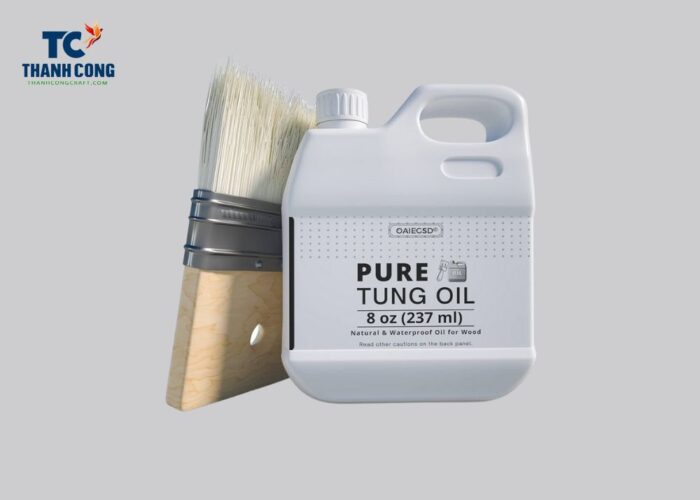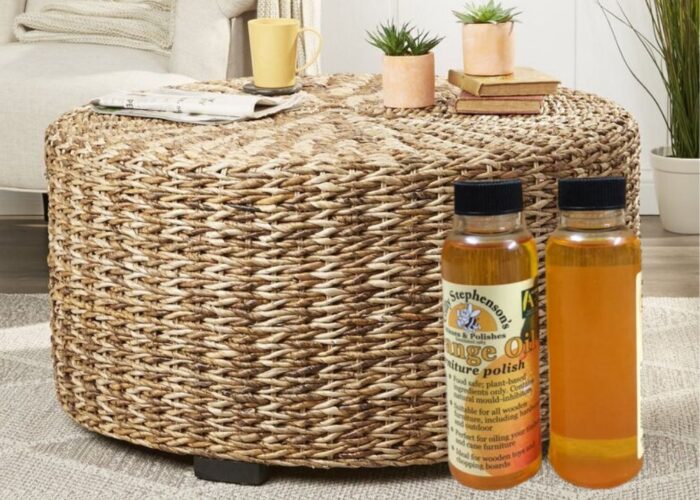Ensuring the longevity and beauty of your seagrass furniture involves a crucial step: sealing. In this guide, we will delve into the intricate details of how to seal seagrass furniture. This comprehensive walkthrough will equip you with the knowledge and techniques needed to protect and preserve your seagrass pieces effectively.
Let’s embark on a journey to discover the best practices for sealing seagrass furniture to keep it looking pristine for years to come.
1. Best Oil for Seagrass Furniture
When it comes to preserving and enhancing the beauty of your seagrass furniture, selecting the right seagrass oil is crucial. Here are some top contenders:
1.1 Tung Oil
One of the key advantages of Tung oil is its ability to penetrate deep into the seagrass fibers, providing a protective layer that helps resist water, moisture, and other environmental factors. This penetration not only safeguards the seagrass against potential damage but also enriches its natural color and texture.

Application of Tung oil is a straightforward process. Begin by cleaning the seagrass furniture, removing any dust or debris. Then, using a clean cloth or a brush, evenly apply Tung oil over the entire surface.
It’s essential to work the oil into the seagrass fibers to ensure thorough coverage. Allow the oil to be absorbed and dry completely, which may take 24 hours or more, depending on environmental conditions.
The result is a lustrous finish that not only enhances the aesthetic appeal of the seagrass furniture but also provides long-lasting protection. Tung oil creates a water-resistant barrier that can prevent issues such as dryness, cracking, and mold growth.
1.2 Linseed Oil
Linseed oil stands out as a versatile and effective option for the care and maintenance of seagrass furniture. Seagrass, with its inherent beauty and resilience, benefits from the nourishing and protective properties of linseed oil.
Derived from flaxseeds, linseed oil is known for its ability to penetrate deeply into materials, including seagrass fibers. This penetration helps in providing a protective coating that guards against environmental elements, such as moisture, sunlight, and changes in humidity.
Beyond protection, linseed oil also enhances the natural colors and textures of seagrass, contributing to its aesthetic appeal.
1.3 Lemon Oil
Lemon oil is a refreshing and aromatic option for maintaining and rejuvenating seagrass furniture. Seagrass, prized for its natural charm and durability, benefits from the gentle and nourishing properties of lemon oil, making it a suitable choice for those looking to add a citrus-infused touch to their furniture care routine.

One of the notable characteristics of lemon oil is its ability to clean, condition, and impart a fresh scent to surfaces. When applied to seagrass furniture, lemon oil serves as a natural cleanser, effectively removing dirt and grime that may accumulate over time.
Additionally, it provides a light and pleasing fragrance that enhances the overall ambiance. Regular application, every few months or as needed, can contribute to maintaining the vitality and natural beauty of seagrass furniture.
1.4 Teak Oil
Teak oil is a popular and effective choice for enhancing and preserving the beauty of seagrass furniture. Renowned for its versatility and protective qualities, teak oil can be a valuable asset in the care routine for seagrass pieces, helping to maintain their natural allure.
Seagrass furniture, known for its durability and aesthetic appeal, can benefit from the nourishing and water-resistant properties of teak oil.
Teak oil not only protects seagrass from potential issues like dryness and cracking but also enriches its natural color and texture. The oil enhances the aesthetic appeal of seagrass furniture, giving it a warm and lustrous finish.
1.5 Water-Based Sealers
Water-based sealers are a popular and eco-friendly choice for protecting and enhancing seagrass furniture. Seagrass furniture, known for its natural beauty and durability, requires careful maintenance to withstand environmental factors and maintain its aesthetic appeal. Water-based sealers offer a protective layer without the strong odors or environmental concerns associated with some solvent-based alternatives.

Typically, the process involves cleaning the furniture, allowing it to dry, and then evenly applying the sealer using a brush or sprayer. Multiple coats may be necessary, with adequate drying time between each application.
2. How to Seal Seagrass Furniture?
Sealing seagrass furniture involves a few key steps to ensure proper protection and longevity. Here’s a comprehensive guide on how to seal seagrass furniture:
Step 1: Clean the Furniture
Initiate the sealing process by meticulously cleaning the seagrass furniture to eliminate accumulated dust, dirt, or debris. Optimal cleanliness is vital as it ensures that the sealer adheres effectively and penetrates the seagrass fibers for maximum protection.
Employ a gentle approach by using a damp cloth or a soft brush, ensuring a thorough but delicate removal of surface impurities. This meticulous cleaning process not only contributes to the overall aesthetics of the seagrass furniture but also ensures that the subsequent application of the sealer is more effective.
Step 2: Allow to Dry
Ensuring that the seagrass is entirely dry is a crucial prerequisite before embarking on the sealing process. Moisture, if present, can impede the sealer’s ability to adhere to the seagrass fibers and compromise its overall efficacy.
Additionally, applying a sealer on damp seagrass may result in an uneven distribution, hindering the formation of a uniform protective barrier.

It is advisable to allow ample time for the seagrass furniture to air-dry naturally, promoting the evaporation of any residual moisture trapped within the fibers. During this waiting period, it is essential to keep the furniture in a well-ventilated area, away from direct sunlight or sources of heat.
Step 3: Choose the Right Sealer
Options abound in the realm of sealers, offering diverse formulations tailored to specific needs. Among the choices are oil-based sealers such as teak oil or linseed oil, as well as water-based sealers. Each type brings distinct advantages, and the decision should align with the particular characteristics you desire for your seagrass furniture.
Step 4: Apply the Sealer
Utilize a clean cloth, sponge, or brush for the application of the sealer. The choice of applicator depends on the intricacy of the seagrass weave and personal preference.
Apply the sealer evenly across the entire seagrass surface. Start from one end and work your way systematically to the other, ensuring that the sealer is spread consistently. This even application is crucial for achieving a uniform protective layer.
Adhere to the product’s instructions regarding the number of coats required. Some sealers may recommend multiple coats to achieve the desired level of protection. Allow each coat to dry completely before applying the next, ensuring a seamless and effective build-up of the protective barrier.
Step 5: Allow for Absorption
Once the sealer has been meticulously applied to the seagrass furniture, the subsequent step is to grant adequate time for the absorption of the sealer into the intricate fibers of the seagrass. This phase is essential as seagrass tends to absorb sealers at varying rates, influenced by factors such as ambient conditions, humidity, and the density of the weave.

Depending on the environmental conditions and the specific characteristics of the seagrass, the absorption time can range from several hours to a full day. It is advisable to allow for a sufficiently extended period to ensure that the sealer has thoroughly permeated the seagrass fibers, contributing to a more resilient and durable protective layer.
Step 6: Optional Additional Coats
Depending on the type of sealer selected and the desired level of protection, you may choose to apply one or more additional coats. Some sealers are designed to provide optimal protection with a single application, while others may recommend multiple coats for enhanced durability.
Additional coats contribute to building a thicker and more robust protective barrier on the seagrass furniture. This can be especially beneficial for items exposed to harsher environmental conditions, such as outdoor furniture subject to constant weathering.
Step 7: Dry Completely
Allowing the sealer to dry completely is crucial to prevent any potential damage that might occur if the furniture is used prematurely. The complete drying of the sealer allows it to fully bond with the seagrass fibers, creating a protective barrier that enhances the furniture’s resistance to moisture, sunlight, and other potential sources of damage.
The recommended drying time may vary depending on the type of sealer used and environmental conditions. Refer to the product instructions for specific guidance on how long the drying process is expected to take.
Step 8: Regular Maintenance
Different sealers have varying lifespans and degrees of durability. Some may necessitate more frequent maintenance, while others offer long-lasting protection.
Regular reapplication of the sealer not only reinforces the protective barrier but also contributes to preserving the appearance of the seagrass furniture. This proactive measure helps prevent issues such as dryness, cracking, or color fading, ensuring that the furniture maintains its natural beauty over time.
Refer to the specific guidelines provided by the sealer manufacturer to determine the recommended intervals for reapplication.
3. FAQs
3.1 Is Seagrass Furniture Durable?
Yes, seagrass is very durable and often used to create inspired works of furniture that are comfortable, attractive and designed to withstand normal wear and tear. Seagrass fibers are known for their durability, making them suitable for crafting various types of furniture, including rush chair seat, sofas, seagrass rug, and storage units.
3.2 Can Seagrass Mold?
Yes, seagrass can be susceptible to mold under certain conditions. Seagrass is a natural fiber derived from plants that grow in coastal areas. Like other natural materials, seagrass can be affected by moisture and humidity, creating an environment conducive to mold growth. Here are factors that can contribute to seagrass molding:
- Excessive Moisture: Seagrass can absorb moisture, especially in humid conditions or if it comes into direct contact with water. When seagrass furniture or items are consistently exposed to excessive moisture, it creates an environment where mold can thrive.
- Damp Conditions: Seagrass furniture stored in damp or humid environments, such as basements or poorly ventilated storage areas, is more prone to mold growth.
3.3 Can Seagrass Furniture be Used Outdoors?
No, seagrass furniture should not be used outdoors. Seagrass furniture cannot withstand rain or moisture. Seagrass furniture is made from natural fibers, and all natural fibers are prone to mold and mildew when exposed to rain or moisture.
Moreover, seagrass is a type of marine plant, and when dry, seagrass cannot resist harsh weather or prolonged rain, often leading to decay. Therefore, you should keep seagrass furniture indoors, and if you have to take them outside, protect them from rain and bad weather
In conclusion, mastering the art of preserving and enhancing seagrass furniture involves a crucial step: sealing. The intricate details of how to seal seagrass furniture provide the key to unlocking its longevity and maintaining its inherent beauty. This comprehensive guide equips you with the knowledge and techniques needed to protect and preserve your seagrass pieces effectively.
If you have any further questions, don’t hesitate to send thanhcongcraft an email us at info@thanhcongcraft.com or message us at WhatsApp: +84967485411. Hope to serve you soon! Best regard!


